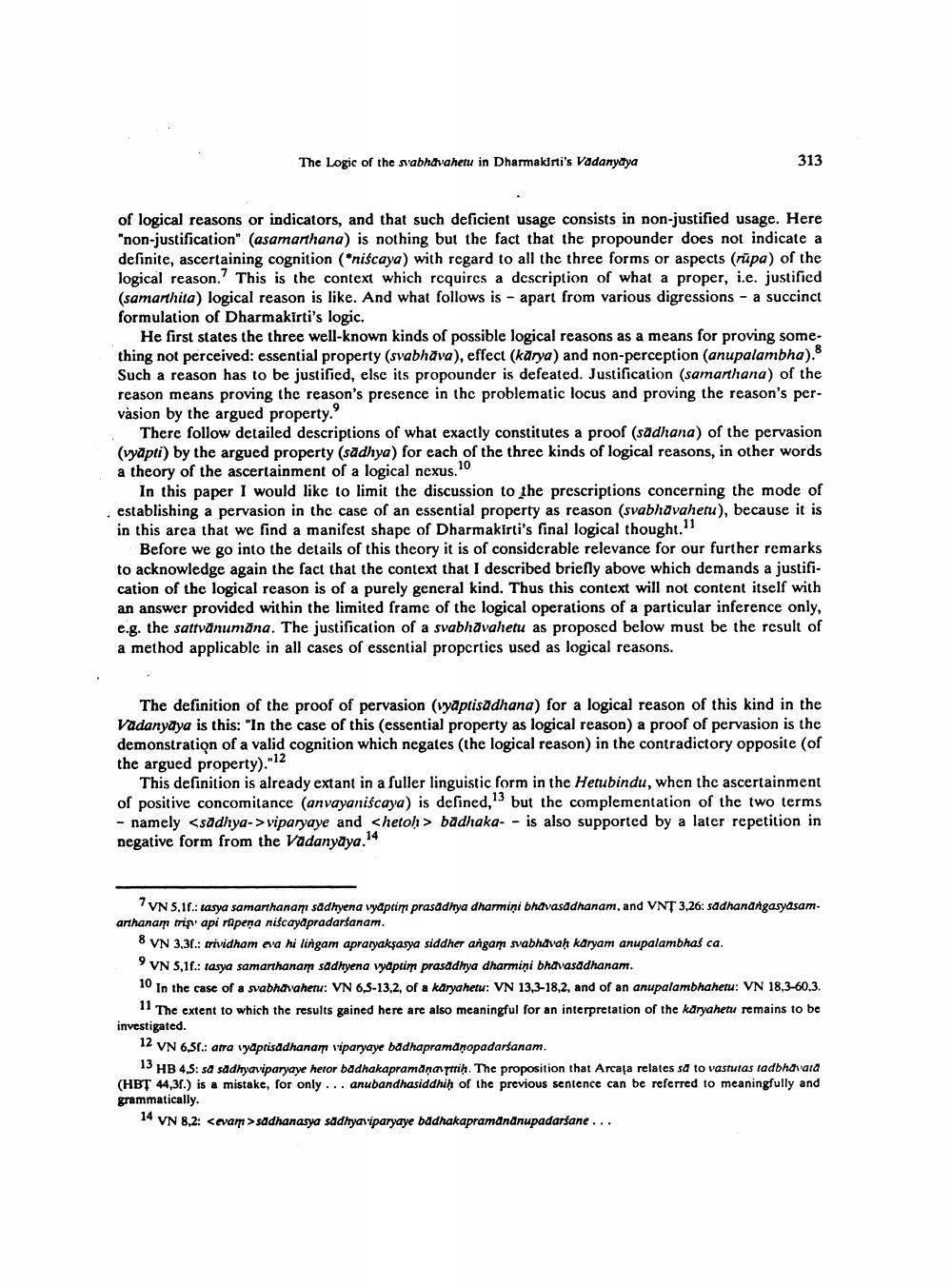Book Title: Logic Of Svabhavahetu In Dhharmakirtis Vadanyaya Author(s): Ernat Steinkellner Publisher: Ernat Steinkellner View full book textPage 3
________________ The Logic of the svabhavahetu in Dharmakirti's Vadanyaya 313 of logical reasons or indicators, and that such deficient usage consists in non-justified usage. Here "non-justification" (asamarthana) is nothing but the fact that the propounder does not indicate a definite, ascertaining cognition (*niscaya) with regard to all the three forms or aspects (rūpa) of the logical reason. This is the context which requires a description of what a proper, i.e. justified (samarthita) logical reason is like. And what follows is - apart from various digressions - a succinct formulation of Dharmakirti's logic. He first states the three well-known kinds of possible logical reasons as a means for proving something not perceived: essential property (svabhāva), effect (kārya) and non-perception (anupalambha).8 Such a reason has to be justified, else its propounder is defeated. Justification (samarthana) of the reason means proving the reason's presence in the problematic locus and proving the reason's pervasion by the argued property." There follow detailed descriptions of what exactly constitutes a proof (sādhana) of the pervasion (vyapti) by the argued property (sadhya) for each of the three kinds of logical reasons, in other words a theory of the ascertainment of a logical nexus.10 In this paper I would like to limit the discussion to the prescriptions concerning the mode of . establishing a pervasion in the case of an essential property as reason (svabhāvahetu), because it is in this area that we find a manifest shape of Dharmakirti's final logical thought.11 Before we go into the details of this theory it is of considerable relevance for our further remarks to acknowledge again the fact that the context that I described briefly above which demands a justification of the logical reason is of a purely general kind. Thus this context will not content itself with an answer provided within the limited frame of the logical operations of a particular inference only, e.g. the sattvānumāna. The justification of a svabhavahetu as proposed below must be the result of a method applicable in all cases of essential properties used as logical reasons. The definition of the proof of pervasion (vyāptisādhana) for a logical reason of this kind in the Vadanyaya is this: "In the case of this (essential property as logical reason) a proof of pervasion is the demonstration of a valid cognition which negates (the logical reason) in the contradictory opposite (of the argued property)."12 This definition is already extant in a fuller linguistic form in the Hetubindu, when the ascertainment of positive concomitance (anvayaniscaya) is defined,13 but the complementation of the two terms - namely <sadhya->viparyaye and <hetoḥ> badhaka-- is also supported by a later repetition in negative form from the Vadanyaya.14 7 VN 5.1f.: tasya samarthanam sadhyena vyaptim prasadhya dharmini bhāvasādhanam, and VNT 3,26: sadhanāngasyasamarthanam triş api rapena niscayapradarśanam. 8 VN 3,3f.: trividham eva hi lingam apratyaksasya siddher angam svabhāvaḥ kāryam anupalambhas ca. 9 VN 5,1f.: tasya samarthanam sädhyena vyäptim prasādhya dharmiņi bhāvasādhanam. 10 In the case of a svabhavahetu: VN 6,5-13,2, of a karyahetu: VN 13,3-18,2, and of an anupalambhahetu: VN 18,3-60,3. 11 The extent to which the results gained here are also meaningful for an interpretation of the karyahetu remains to be investigated. 12 VN 6,5f.: atra vyaptisadhanam viparyaye badhapramāṇopadarsanam. 13 HB 4,5: så sädhyaviparyaye hetor badhakapramanattiḥ. The proposition that Arcata relates sa to vastutas tadbhāvātā (HBT 44,3f.) is a mistake, for only... anubandhasiddhiḥ of the previous sentence can be referred to meaningfully and grammatically. 14 VN 8,2: <evam>sadhanasya sädhyaviparyaye badhakapramänänupadarśane...Page Navigation
1 2 3 4 5 6 7 8 9 10 11 12 13
